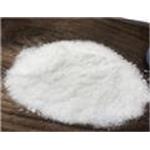1-Naphthol: pharmacokinetics, activities and toxicity
Jul 12,2023
General Description
1-Naphthol, also known as Duloxetine EP Impurity D, a compound with antioxidant activity, exhibits first-order kinetics. It is rapidly absorbed through the skin, eyes, and respiratory tract, but not via ingestion. It accumulates in lipid-rich tissues and has an elimination half-life of 2-3 hours. Metabolism occurs in the liver through oxidation and conjugation, followed by excretion in urine and bile. It protects cells from oxidative stress by scavenging reactive oxygen species and enhancing antioxidant enzyme production. However, oral toxicity studies in mice showed acute toxicity at high doses, leading to mortality and kidney and stomach lesions. Repeat dosing at lower doses was tolerable with minor gastric effects.

Figure 1. 1-Naphthol
Pharmacokinetics
1-Naphthol is a compound that exhibits first-order kinetics, meaning that its rate of reaction is directly proportional to the concentration of the reactants. This property makes it suitable for studying enzyme kinetics. When it comes to absorption, 1-naphthol is rapidly absorbed through the skin, eyes, and respiratory tract. However, it is not absorbed when ingested through the gastrointestinal tract. The distribution of 1-naphthol in the body is influenced by factors such as pH, solubility, and protein binding. It tends to accumulate in lipid-rich tissues such as the brain, eyes, and adipose tissue. The elimination half-life of 1-naphthol is approximately 2-3 hours. In the liver, it undergoes metabolism primarily through oxidation and conjugation with glucuronic acid. The resulting metabolites are then excreted from the body through urine and bile. 1
Activities
1-Naphthol is a compound with antioxidant activity. Antioxidant activity refers to its ability to counteract free radicals, which are chemical substances that cause cellular damage and aging. Studies have shown that 1-Naphthol can protect cells from oxidative stress by reducing the generation of free radicals or neutralizing existing ones. It can scavenge reactive oxygen species such as peroxyl radicals and hydroxyl radicals, preventing them from triggering chain reactions. This antioxidant effect can inhibit oxidative reactions such as lipid peroxidation and DNA damage. Furthermore, 1-Naphthol has the ability to enhance the cellular antioxidant enzyme system. It can stimulate the production of important enzymes such as glutathione peroxidase (GPX), superoxide dismutase (SOD), and glutathione-S-transferase (GST), which play a critical role in free radical clearance. Overall, 1-Naphthol exhibits promising activity as an antioxidant, contributing to the clearance of free radicals and protection of cells from oxidative stress. 2
Toxicity
The oral toxicity of 1-Naphthol was investigated in Charles River CD1 mice through single-dose and repeat dosing studies. In the single-dose study, mice were administered doses of 2 g/kg, 1 g/kg, and 0.5 g/kg body weight. Mice dosed at 2 g/kg experienced mortality or were euthanized due to critical condition within 15 to 90 minutes after dosing. The mice treated at 1 g/kg survived until the end of the study (14 days post-dosing), but one male in the 0.5 g/kg dose group was euthanized approximately 2 hours after treatment. Histopathological examination revealed kidney and stomach lesions in mice from all treatment groups in the single-dose study. Kidney lesions included degeneration of the distal tubule epithelium, papillary necrosis, and tubular dilatation. Stomach changes consisted of splitting of the epithelium in the forestomach and sloughing of superficial epithelium in the glandular mucosa, often accompanied by vascular congestion and infiltration of acute inflammatory cells. In summary, 1-Naphthol demonstrated acute toxicity in mice, with higher doses leading to mortality and critical conditions shortly after dosing. Histopathological analysis revealed kidney and stomach lesions in mice from all treatment groups. Repeat dosing at lower doses showed tolerability, with some male mice exhibiting gastric histopathological effects. However, there were no kidney lesions or significant changes in hematological or clinical chemistry parameters observed in the 30-day study. 3
Reference
1. Chern WH, Dauterman WC. Studies on the metabolism and excretion of 1-naphthol, 1-naphthyl-beta-D-glucuronide, and 1-naphthyl-beta-D-glucoside in the mouse. Toxicol Appl Pharmacol, 1983, 67(3):303-309.
2. Sugahara S, Fukuhara K, Tokunaga Y, et al. Radical scavenging effects of 1-naphthol, 2-naphthol, and their sulfate-conjugates. J Toxicol Sci, 2018, 43(3):213-221.
3. Poole A, Buckley P. 1-Naphthol--single and repeated dose (30-day) oral toxicity studies in the mouse. Food Chem Toxicol, 1989, 27(4):233-238.
- Related articles
- Related Qustion
- 1-Naphthol: Natural Occurrence and its Catabolism via Synergistic Regulation May 17, 2024
1-Naphthol, a genotoxin and xenobiotic metabolite, occurs naturally, posing ecological, biochemical, and toxicological implications, crucial for environmental sciences.
- 1-Naphthol: Production and Uses Nov 18, 2022
The passage introduces the production and uses of 1-Naphthol.
Adenine (A) is a nucleotide base found in DNA, alongside cytosine (C), guanine (G), and thymine (T). It is also known as one of the impurities in Adenosine Ep.....
Jul 11,2023Analytical Chemistry1,1,3,3-Tetramethyldisiloxane enhances battery performance and is compatible with various materials. Follow safety precautions when using it.....
Jul 12,2023API1-Naphthol
90-15-3You may like
- 1-Naphthol
-

- $1.00 / 25KG
- 2024-05-24
- CAS:90-15-3
- Min. Order: 1KG
- Purity: 99%
- Supply Ability: 2000mt/year
- Dapoxetine impurity 70
-

- $0.00 / 10mg
- 2024-05-21
- CAS:90-15-3
- Min. Order: 10mg
- Purity: 0.98
- Supply Ability: 10g
- 1-Naphthol
-

- $6.00 / 1kg
- 2024-05-10
- CAS:90-15-3
- Min. Order: 1kg
- Purity: More than 99%
- Supply Ability: 2000KG/Month




